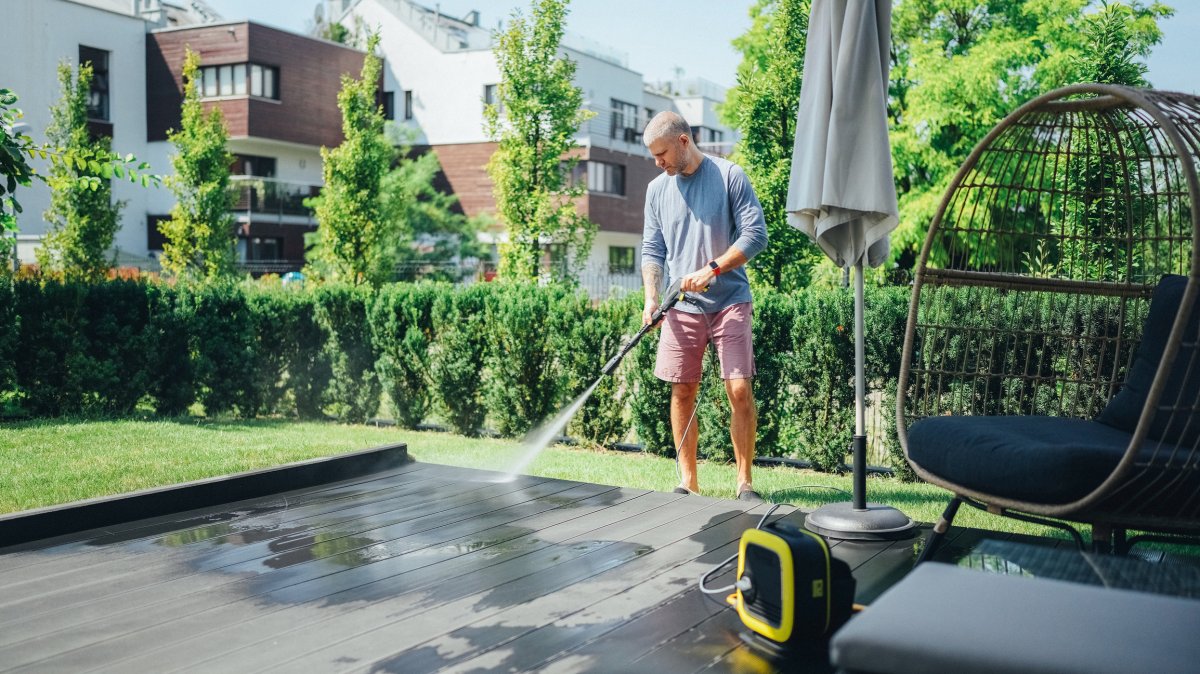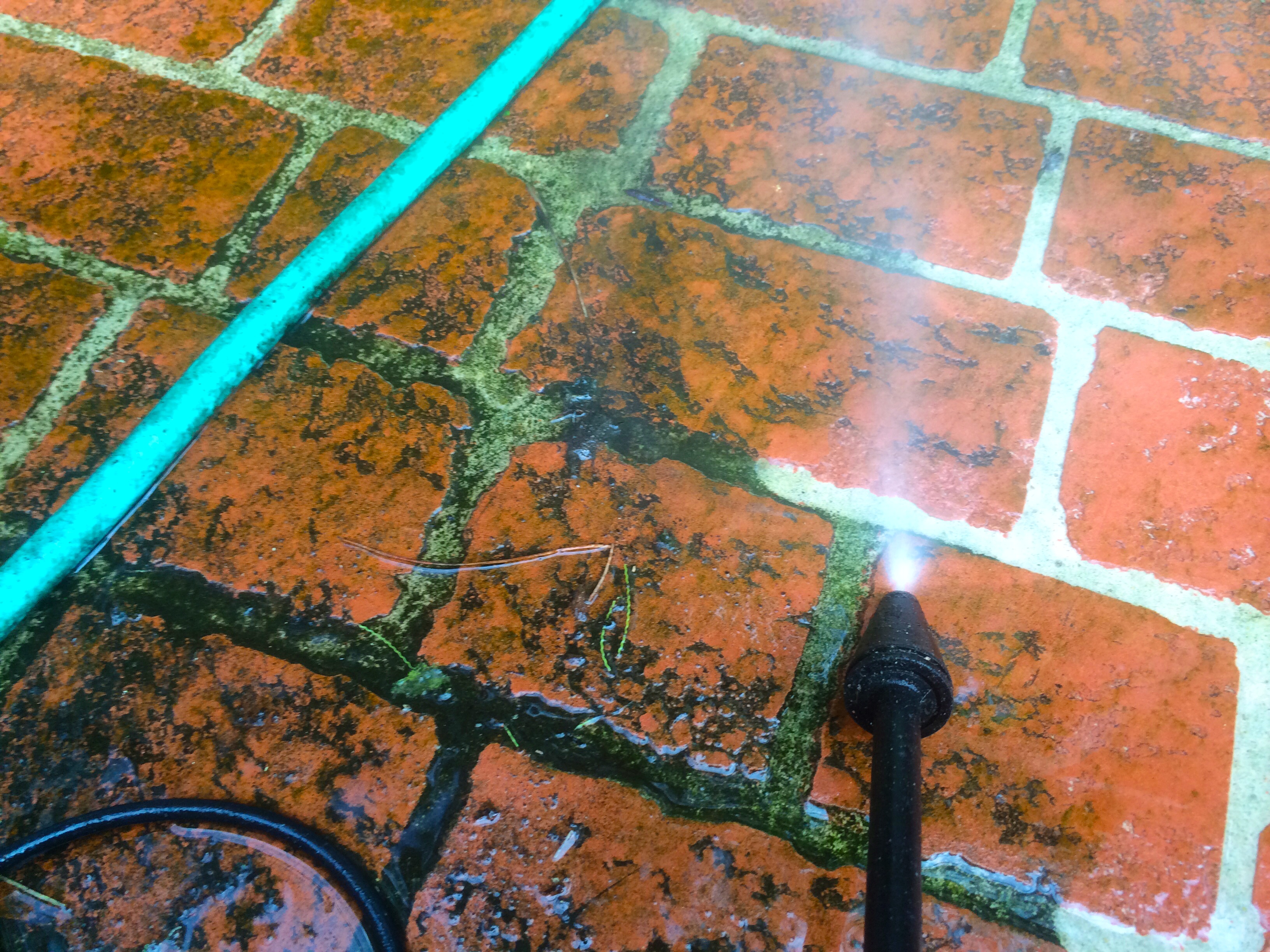

We may earn revenue from the products available on this page and participate in affiliate programs. Learn More ›
After months of chilly weather, spring is the perfect time to head outdoors and soak up some fresh air on the patio. But this year, many parts of the United States are seeing a wetter-than-average season, and that extra moisture can bring some unwelcome guests.
Shaded patios in particular are susceptible to gunk and algae or moss growth, which can make their surfaces slippery and unattractive, plus require cleaning that cuts into the time you get to spend outside relaxing or entertaining. Understanding how to address mold, algae, and moss on a patio can help you keep your outdoor space clean and safe so you can enjoy it throughout the season.
“A clean patio not only enhances your home’s comfort and style but also increases its overall appeal,” says Justin Carpenter, founder and CEO of Jacksonville Maids in Jacksonville, Florida. “By successfully removing these nuisances, you create a welcoming space that boosts the value of your property, making your home a real showplace.”
We spoke to several patio-cleaning experts to discover their best solutions for removing moss, mold, and algae, and how to prevent these culprits from reappearing in the future.

Start with some scrubbing.
To start removing buildup on your patio’s concrete, pavers, or wood surfaces, scrub the surface with a stiff-bristle brush and a solution of water mixed with oxygenated bleach, says Jason Farr, owner of Aviara Pavers Inc. in San Diego, California. “This lifts growth without damaging the material,” he says. Be sure to avoid chlorine bleach, which can degrade pavers and nearby landscaping. Next, rinse thoroughly with a hose or pressure washer on a low setting to avoid surface damage, especially on softer stone or wood.
For more sensitive surfaces, such as flagstone, stick with a gentle cleaner (stone-safe, pH-neutral), a soft-bristle brush. Avoid vinegar unless you’re trying to make your patio fizz like a baking soda volcano, says Todd Anderson, owner of Cascade Cleaning Services in Richland, Washington.
Use a pressure washer for tough stains.
Pressure washing directs high-pressure water streams to blast away dirt and grime. “For tackling the challenge of removing moss, algae, and mold from a patio, all you need is to embrace innovative cleaning techniques that combine powerful tools with effective solutions,” explains Carpenter. “You can use power washing with a wide-angle spray nozzle for a high-impact clean.
Landscape contractor and STIHL spokesperson Sara Bendrick highlights the STIHL REA 60 PLUS, which can take on tough jobs. “It is portable and maneuverable, providing continuous pressure of 1,500 PSI to strip away moss, algae, and mold from concrete, pavers, flagstone, and even wood,” says Bendrick. “The 3-in-1 nozzle allows you to easily switch between the flat-jet and detergent settings.”
Bendrick recommends working in squares or segments one after the other instead of random patterns to ensure consistent cleaning. “Also, if you’re pressure-washing wood decking, just be sure to use a wide fan tip and wash with the grain of the wood.” Keep the pressure light or it can ruin the wood.

When in doubt, choose soft washing instead.
For delicate patio materials like wood and flagstone, it’s best to use soft washing instead of pressure-washing. While pressure washing ranges from 1,500 to 3,000 pounds per square inch, or PSI, soft washing is a low-pressure method under 500 PSI, combined with biodegradable cleaners to safely kill and remove growth. These solutions—including bleach, surfactants, neutralizers, and odor removers—settle in the layers of dirt, destroying the buildup from the inside.
Soft-washing tools are gentle, easy to manage, and typically have long-lasting results. However, this technique might not remove certain stains, such as embedded dirt, that a powerful pressure washer can tackle more effectively. It can also take a longer time to clean an area with the soft-washing method.
Prevent growth from making a comeback.
To prevent regrowth, focus on moisture management and sunlight exposure, says Farr. Here are some specific tips to prevent mold, algae, and moss on a patio from making a reappearance, according to Anderson.
- Sunlight is your friend: Moss doesn’t like sunshine, so trim overhanging tree limbs to ensure your patio can catch some rays.
- Improve drainage: If puddles build up on your patio, regrade it or add gravel to help water drain properly.
- Use a moss/algae treatment spray: There are patio-safe preventives containing ingredients such as ferrous ammonium sulfate you can spray once the surface is clean; be sure to check all product precautions.
- Seal it up: A good sealer adds a water-repellent barrier and makes it harder for organic gunk to dig in for a second act.
- Regularly sweep away debris: Keep a broom or leaf blower handy and give your patio a quick once-over every few days. The less dirt, moisture, leaves, and other debris building up on your patio, the less likely green gunk will return.
